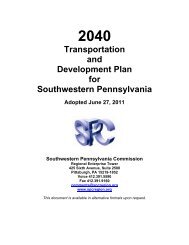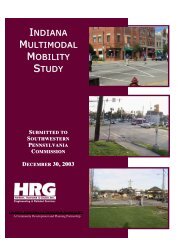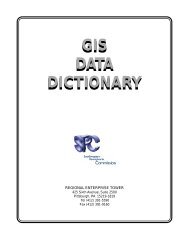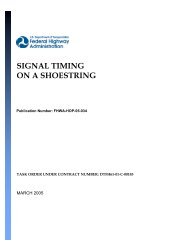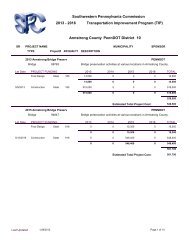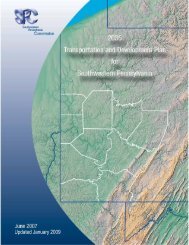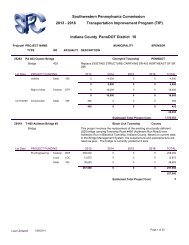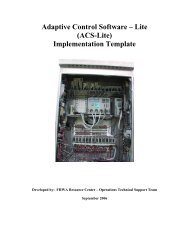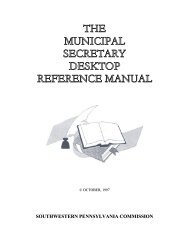Minutes - Southwestern Pennsylvania Commission
Minutes - Southwestern Pennsylvania Commission
Minutes - Southwestern Pennsylvania Commission
You also want an ePaper? Increase the reach of your titles
YUMPU automatically turns print PDFs into web optimized ePapers that Google loves.
Notes from SPC Pedestrian‐Advisory Committee Meeting<br />
August 12, 2009<br />
Attendees:<br />
John Haven, Buffalo Township/Butler Freeport Community Trail<br />
Bob Dudash, URS Corporation<br />
Steve Patchan, City of Pittsburgh<br />
Roy Weil, Free Wheelin Easy<br />
Mary Shaw, Free Wheelin Easy<br />
Ned Williams, Montour Trail, Panhandle Trail, WPW<br />
Liz Namm, Oakland TMA<br />
Lynn Manion, ACTA<br />
Jim Vauter, PennDOT District 10<br />
Amy Camp, Trail Towns Program<br />
Ryan Gordon, SPC<br />
Sara Walfoort, SPC<br />
Cort McCombs, SPC<br />
Robin Kamin, TRIC<br />
Susheela Nemani‐Stanger, URA<br />
Brian Lawrence, Indiana County Office of Planning and Development<br />
Jerrold Green, Citizen<br />
Seth Gernot, Venture Outdoors<br />
Gene Slevinski, National Skate Patrol, TRIC<br />
Amanda Broadwater, City of Pittsburgh, DPW<br />
Jon Smith, Allegheny County Transit Council<br />
Bill Evans, Beaver County Planning <strong>Commission</strong><br />
Tract Stack, PA DCNR<br />
Doniele Andrus, Beaver and Lawrence County Trails and Greenways<br />
Lynn Heckman, Allegheny County<br />
Chuck Imbrogno, SPC<br />
Lucinda Beattie, Pittsburgh Downtown Partnership<br />
Eve Picker, No Wall Productions, Inc.<br />
Anthony Boule, Pittsburgh Parking Authority<br />
Scott Brilhart, Upper St. Clair Township<br />
Welcome by SPC<br />
New building security will be in place by the October meeting. Visitors to the building will be required to<br />
show a photo ID when signing in at the lobby. Frequent visitors to the building may request a building
access pass (permanent), but will be required to remember to wear/bring it on meeting days. Visitors<br />
unable to show a photo ID will be required to be escorted by a building tenant while in the building.<br />
Review of Additional Handouts not included in Agenda Package<br />
Report on SPC Federal Certification Review<br />
Every four years the US Department of Transportation (Federal Highway Administration and Federal<br />
Transit Administration) review the regional transportation planning program in each Metropolitan<br />
Planning Organization. The USDOT team came to Pittsburgh last week for the review of the SPC region.<br />
While SPC is the “host” for this review, all transportation planning partners in the region participate in<br />
the review process, including PennDOT, the transit agencies, out county planning partners, etc.<br />
The federal certification review report will be provided to SPC within 90 days. Comments heard at the<br />
Certification Review that might be of particular interest to the Ped‐Bike community include:<br />
FHWA Regional Administrator for <strong>Pennsylvania</strong> (Renee Sigel) saying that she expects the next<br />
transportation authorization bill to include provisions for greenhouse gas reductions, livable, sustainable<br />
communities, etc. She suggested that a word like “livable” might even be in the title of the new<br />
transportation bill.<br />
At the evening Open House/Public Forum, Scott Bricker of Bike Pittsburgh provided comments on the<br />
need for greater bicycle accommodation in the region, and the need for dedicated mandates and<br />
dedicated funding streams to make bicycle and pedestrian improvements in the region.<br />
At the close of the Federal Certification review, the USDOT noted a few of their observations, including<br />
the “need for greater bicycle accommodation at transit locations.” More details are likely to be<br />
forthcoming as part of the formal Certification Review report.<br />
The public comment period associated with the USDOT Federal Certification Review of the<br />
<strong>Southwestern</strong> <strong>Pennsylvania</strong> <strong>Commission</strong> MPO remains open through September 7, 2009. Comments<br />
may be directed to Matt Smoker, Federal Highway Administration at Matt.Smoker@dot.gov<br />
CMAQ Program<br />
Chuck Imbrogno of SPC provided an update on the upcoming CMAQ program. Given the volatility or<br />
uncertainty in the federal transportation program, he provided our current “best guess” as to what the<br />
program will look like for the 2010 TIP adoption, and what the most likely schedule will be.<br />
Program applications/instructions are currently under development at SPC. We expect that the<br />
application window for the next round of CMAQ funding will open in mid to late August, and run<br />
through the first Monday in October. While there is some uncertainty as to the TIP adoption schedule,<br />
we DO expect to adopt a new TIP, which will include the new CMAQ funded projects, in the summer of<br />
2010.
Following months of diligent effort, a CMAQ process review team has developed a clear CMAQ<br />
application review process that will be utilized. Steve Patchan of the City of Pittsburgh participated in<br />
that Committee as the designated ped‐bike representative. This process was recently reviewed and<br />
approved by the SPC Executive Committee.<br />
New to this round of CMAQ funding will be a focus on not only getting projects funded, and on the TIP,<br />
but getting projects moved OFF the TIP (as in implemented).<br />
As always, this program is designed to fund TRANSPORTATION projects that result in an enhancement of<br />
regional air quality through a reduction in VMT, idle reduction through congestion relief or technological<br />
improvements such as diesel engine retrofits, etc. The program has a great deal of flexibility, but the<br />
focus of the program (and candidate projects) should be on the commuter.<br />
Trails Update on SPC GIS Databases<br />
Cort McCombs of SPC told the group of his efforts to update the SPC GIS database relative to trails. His<br />
focus at this time is on the attribute structure of the data layer, and the consistency thereof. SPC is<br />
currently examining the best ways to reflect issues such as trail status (existing, funded and potential<br />
being the likely descriptors), permitted uses (hiking only, biking/hiking, equestrian, etc.), trail surface<br />
(paved/unpaved) and shared road category to depict trail segments that follow existing roadways, as<br />
well as bike lanes on public streets, etc.<br />
It was noted that DCNR is completing a similar effort, and as SPC and DCNR are both members of the PA<br />
GIS network, there is considerably opportunity for data sharing. We plan to use their data to the extent<br />
possible, so as to be able to overlay trail data with any of SPC’s 100 or more other data layers. It is not<br />
our intent to duplicate work already being completed by others.<br />
SPC will be reaching out to trail groups for their assistance on this update project. At the<br />
recommendation of this group, SPC will consider creating a form or a format that could be provided to<br />
trail groups for their use in providing the requested data updates.<br />
A major detail still to be resolved relates to trail naming and nomenclature. With the emergence of trail<br />
systems, it is sometimes hard to know what to call a given trail or trail segment. We intend to work with<br />
the trail groups on this question, so as to determine when and where the designation “Yough River Trail”<br />
might be appropriate, and when and where “Great Allegheny Passage” might be appropriate, for<br />
example. Recognizing that local usage and the desire for trail system “branding” are important<br />
components of the regional trail system, we will work to develop a naming system that works for<br />
everyone.<br />
Bike Suitability Mapping<br />
Ryan Gordon of SPC provided an update on SPC’s Bike Suitability mapping effort. As noted in previous<br />
meetings, draft maps for Allegheny and Greene Counties are available on the SPC website. The base<br />
mapping has been created for Beaver County, and is under development for Indiana County. Local<br />
cyclists will be lined up to assist with the classification of roadways in their home counties. The effort in
Indiana County will coincide with the development of a Pedestrian/Bicycle Plan for the county, and<br />
effort that is currently ongoing.<br />
Somewhat unrelated, but the question was raised about the possibility of enhanced coordination with<br />
PennDOT to identify road scheduled to be tarred and chipped, as this riding surface is problematic for<br />
cyclists. SPC staff will look into the matter and report back at the next meeting of the Ped‐Bike Advisory<br />
Committee in October. Similar concerns were raised regarding shoulder treatments, rumble strips and<br />
other design elements.<br />
Regional Updates<br />
Doniele Andrus, Beaver and Lawrence Counties, reports that the reconstruction of the Stavich Trail is<br />
underway, and a paving contract should be in place by the end of the year. (It was noted that the<br />
Lowellville portion of the trail, in Ohio, is an on‐road trail for a brief stretch. She also reported that an<br />
RFP is under development for a Monaca to Montour Trail Study, and that the County is working on a<br />
contract amendment with DCNR to further that effort. DCNR and local economic and community<br />
development groups are embracing the county’s water trail development efforts, which Doniele<br />
describes as “going really well.”<br />
Tracy Stack, PA DCNR, reminded those present that the Fifth Annual PA Trails and Greenways Summit<br />
will be held in Blair County in late September. She also noted that the absence of a State Budget will<br />
have the likely result of delaying the announcement of the next round of project funding.<br />
Bill Evans, Beaver County Planning, mentioned that coordination efforts are on‐going with the Ohio<br />
Great Lakes to River Trail group, which will permit connections into <strong>Pennsylvania</strong> at both the Stavich<br />
Trail (at Mill Creek); and at Ohioville, Beaver County. The County’s focus, at present, is the Monaca to<br />
Montour trail. Efforts to coordinate in a meaningful way with the Great Lakes to River Trail will advance<br />
after the Monaca to Montour effort is well underway.<br />
SPC staff made mention of the possibility to also build on Butler City and County efforts to connect the<br />
City of Butler (and Butler Freeport Community Trail) to Moraine State Park. From there, connections<br />
through New Castle to the Stavich Trail or through McConnells Mill towards the Beaver River<br />
communities may also connect one day to the Great Lakes to River Trail in extreme eastern Ohio.<br />
Jon Smith, Citizen stated that his primary interest was pedestrianism and pedestrian access. It is his<br />
belief that PennDOT has become too highway focused, and has neglected the needs of the pedestrian.<br />
The ability to walk along our roadways should be a right, not an exception, or special consideration.<br />
PennDOT should be encouraged to promote wider shoulders and other pedestrian friendly amenities, as<br />
should the City of Pittsburgh. People simply will not walk where it is impossible for them to do so – due<br />
to the lack of a safe corridor, the position of a jersey barrier, or other physical impediment.<br />
Gene Slevinski, National Skate Patrol and Three Rivers Inline Skating Club said that the skating<br />
community was supportive of efforts to extend trails and other advocacy efforts by the bicycling<br />
community. The skaters use the streets and area paved trails several times a week for recreational and
guided rides. They continue to support the placement of a paved surface on trails, to permit use by<br />
skaters. For more information on their efforts/activities, visit www.skatepittsburgh.com.<br />
Seth Gernot, Venture Outdoors, made mention of several upcoming rides on the Great Allegheny<br />
Passage, including a 4 day ride, an 8 day DC to Pittsburgh ride and a fall foliage tour. At the end of the<br />
last big ride, trip participants offered to “tip” the ride escorts. The offer of a tip was declined, but the<br />
trip participants pooled those contributions and donated them to the “cause” in support of the $1.5<br />
million trail completion project. An opportunity for private contributions to the trail<br />
development/maintenance funds will become part of standard trip protocol for future Venture<br />
Outdoors tours on the GAP.<br />
Jerry Green, Citizen raised the question of the true nature of the hold up in GAP trail connections around<br />
the SandCastle site. Is the problem simply money, he asked, or are there other issues. After discussion<br />
around the room, it seemed clear that there were issues aside from money, including the resolution of a<br />
sinkhole issue that PA DEP is working on. There is some question as to where that effort stands, and<br />
how high a priority it is at DEP.<br />
Other items captured during this discussion: in the existing gap in the GAP there are a number of<br />
railroad crossings that have to be made. The flyover bridges for these locations are “ready to go.” Work<br />
could start as early as this fall. It was also reported that property rights had been secured all the way<br />
from McKeesport to Pittsburgh. There was discussion of a possible TIGER grant to resolve some of the<br />
outstanding issues. Generally, the group concurred that SandCastle may have justifiable concerns that<br />
the provision of a trail to their front door may result in an influx of unattended minors in their facility,<br />
etc. But, this issue could be resolved in other ways. The goal is to find a way to work with SandCastle in<br />
a way that encourages them to work to resolve the issues and come to agreement, rather than to<br />
antagonize them. There was also general agreement that if the trail is extended to their doorstep, on<br />
either end of their facility, they’d have to come to some sort of agreement leading to the connection of<br />
the trail. Jon Smith reminded the group that the public has a right to “traverse the strand” which is the<br />
section of the river shoreline between the high water mark and the low water mark. These are not<br />
provisions that we are looking to employ in this case, but it was an important reminder that SandCastle<br />
does not actually OWN the waterfront.<br />
Susheela Nemani‐Stanger, Urban Redevelopment Authority of Pittsburgh described the proposed<br />
development of a new South Side Riverfront Park project that would extend from the Hot Metal Bridge<br />
to the existing South Side Park. This effort is almost fully funded, and a TIGER application has been<br />
submitted to secure the remaining funding. This new park area would include a bike/ped trail, as well as<br />
ADA access all the way to the rivers edge. A boat tie up facility and possible private marina are under<br />
consideration. It is envisioned that work could be complete in 2012. The question of whether<br />
motorized wheelchairs will be permitted on the new trail segment. Most federally funded trails do not<br />
permit any motorized users, including wheelchairs, electric bikes, segways, etc. Some trails have<br />
provisions that permit wheelchairs displaying an HC permit.
Amy Camp, Trail Towns Program, found the update on the gap in the GAP helpful, and pointed that for<br />
their purposes, the official end of the trail is in McKeesport. She also reported that 1300 people<br />
responded to a survey that they put out to determine peoples interest in enhanced bicycle<br />
accommodation on the Amtrak Capital Limited line, which parallels the Great Allegheny Passage for<br />
much of its length. Their goal is to advocate for “roll on/roll off” service for bicyclists. She was<br />
cautioned by members of the group to be clear in the definition of “roll on/roll off” and what types of<br />
cycles that was were being advocated for – recumbent and tandems, for example, have different<br />
geometric needs, and not everyone defines “roll on/roll off” in the same way. Amy also reported that<br />
they had purchased Trafx Infrared Trail Counters, and would be situating them along the trail in coming<br />
weeks. By the end of the cycling season, they should have the start of a reliable “users count.” Finally,<br />
Amy noted that the Trail Towns program was starting a Sustainable Business network (more details to<br />
follow), and that details on all of their activities were available on their Facebook page and twitter<br />
account.<br />
Jim Vauter, PennDOT District 10, reports that the contract for the Armstrong Trail has been let. The<br />
ARRA funded Roaring Run Trail project is currently underway, as are two bridges on the Ghost Town<br />
Trail.<br />
Ned Williams, Montour Trail Council and Western <strong>Pennsylvania</strong> Wheelmen, noted a crucial need for<br />
maintenance funds/programs for our parks and trail infrastructure. We’ve done a great job at creating<br />
these resources, but now we need to figure out how to maintain them as well. Montour Trail Council has<br />
established a trail maintenance endowment fund, for example. They have several small projects<br />
underway, namely the detour reduction at the intersection of Routes 50 and 980 in Washington County,<br />
and the Triphammer Bridge area in Allegheny County. PennDOT review is underway for two bridges in<br />
Cecil Township, Washington County. They are also chipping away at multiple large projects. It is<br />
interesting to note that in typical trail fashion, the trail group has 46 of 50 miles complete, but are only<br />
halfway to the total funds required to complete all 50 miles. The first 80 percent of the project takes 50<br />
percent of the funds…….!<br />
Mary Shaw, Trail Volunteer Fund, The Pittsburgh Foundation provides grants ranging from a few<br />
hundred to a few thousand dollars to trail groups to provide materials/tools for use by volunteers. The<br />
application window is currently open, with applications being accepted through September 1, 2009.<br />
More details can be found at http://theyworking.org/. A description of the ten or so projects funded in<br />
2008 and in 2009 can be found on their website. Mary also noted that the Western <strong>Pennsylvania</strong><br />
Conservancy’s canoe/kayak access fund provides funds for put in facilities (non‐motorized/no vehicle<br />
access.<br />
Jeff Raykes, Indiana County, announced that Indiana County work on a new countywide ped‐bike plan<br />
was keeping them busy. They are also focused on the completion of a feasibility study for the<br />
connection of the West Penn Trail into the network of trails in Indiana County. He also made mention of<br />
a relatively new initiative, the Kiski Valley Connector, which would link 17 communities in three counties<br />
via trail.
Scott Brilhart, Upper St. Clair Township, announced that USC is working on an update to the 10 or 15<br />
year old Sidewalk and Bicycle Plan for the Township. They are also looking at a planning study focused<br />
on school access. They are looking at a new sidewalk along Fort Couch Road, to South Hills Village Mall.<br />
They are also looking to work with the Montour Trail Council on options to connect to the Montour Trail<br />
from Peters Township, following the creek along Valleybrook Road to Upper St. Clair.<br />
Steve Patchan, City of Pittsburgh, indicated that the City of Pittsburgh is likely to apply for Bike Friendly<br />
Status as early as February of 2010. This application is a key element in Steve’s job description as<br />
“Pittsburgh Bicycle Czar.” Steve noted that the City was strong in some areas, less strong in others. But,<br />
the Bike Friendly Status is awarded at four levels – Platinum, Gold, Silver, Bronze and Honorable<br />
Mention, so hopefully there is an opportunity to gain at least an Honorable Mention. Bike Friendly<br />
status is valuable as a marketing tool, but also serves as a building block on which new and better<br />
bicycle accommodation may be based. Beyond that, Steve is working on the issuance of two major<br />
projects: an RFP for a Route Signage Strategic Plan which would recommend routes through the use of<br />
wayfinding/destination signs, and thereby provide Citywide branding of bicycle routing; and an RFP for<br />
an update of the City Bicycle Plan, which should be released soon. Also pending is the Bicycle Parking<br />
Ordinance, which is likely to be considered when City Council reconvenes on September 1 st . The current<br />
proposed ordinance will require the provision of bicycle parking for any new development or re‐use<br />
permit. There will also be incentives for the provision of bicycle parking in other development scenarios.<br />
Vehicle parking requirements for autos are already in the ordinance. More details will be forthcoming at<br />
the October meeting.<br />
John Haven, Buffalo Township and Buffalo Freeport Community Trail, said that their DCNR contract is<br />
ready to go, and the $195,000 project will result in the completion of 4.5 miles of trail to Butler (City).<br />
They have the NPDES permit in hand, as well as the Section 102 and 105 permits. USACE approval is<br />
pending, but they expect that to be processed quickly. The trail will need to end just short of Butler, as<br />
arsenic has been found in the soil adjacent to the proposed trailhead at Father Marinaro Park. They<br />
expect construction to take about 7 weeks. The Township of Buffalo, which owns the trail, is also<br />
looking to purchase a park adjacent to the trail near one of the road crossings. An appraisal is<br />
underway, with the anticipated cost to be in the $160,000 to $185,000 range. They would submit an<br />
application for DCNR funds for one half of the purchase price. The Audubon Society has expressed<br />
interest in posting some displays in the park/along the trail, which is identified in places as an<br />
exceptional birding area. Construction of the Freeport Bridge will require use of the “lower” Laneville<br />
Trailhead parking area (under the bridge) for a construction staging area, resulting in the loss of about<br />
15 parking spaces. PennDOT and Buffalo Township are working to expand parking at the other Laneville<br />
Trailhead a little further into the trail. The interruption to the trailhead is expected to last about three<br />
years. Also in Laneville, the Township is looking into the purchase/re‐use of the original Laneville Train<br />
Station. This structure had been converted into a gas station, but is currently unused. The proposal<br />
would be to relocate the structure to a location along the trail to serve trail users.<br />
Anthony Boule, Pittsburgh Parking Authority, the Pittsburgh Parking Authority is looking into the<br />
possibility of placing bike lockers at the First Avenue location, adjacent to the existing Bike and Blade<br />
Station. Legal and liability reviews are underway, and approvals pending. Anthony also related some of
the Parking Authority’s “best guesses” relative to the G‐20 Summit in late September. They do not<br />
expect to know anything definitive for several weeks, but preliminary thoughts are that the mix of the<br />
First Avenue light rail station and the parking capacity of the First Avenue garage make that location a<br />
logical nexus for emergency operations and/or staging due to the location of the Courts/jail(s) in the<br />
immediate vicinity. That would presumably mean that First Avenue Station would be closed to all other<br />
users for the duration of the two day summit, and potentially for a short time prior to the event.<br />
A discussion of how to accommodate downtown commuters during the transportation disruptions of<br />
the G20 summit then ensued. The idea of placing bicycle racks at key locations just outside the cordon<br />
area was discussed, but the cordon area will not be definitively identified until just before the event,<br />
making rack installation and staging difficult. Lots more remote to downtown, including Station Square,<br />
the Stadiums and Mellon Arena are thought to be logical transit staging areas during the G20 summit.<br />
The meeting concluded with a reminder that the next meeting will be on Wednesday, October 14, 2009<br />
(the second Wednesday in October).<br />
‐ End



